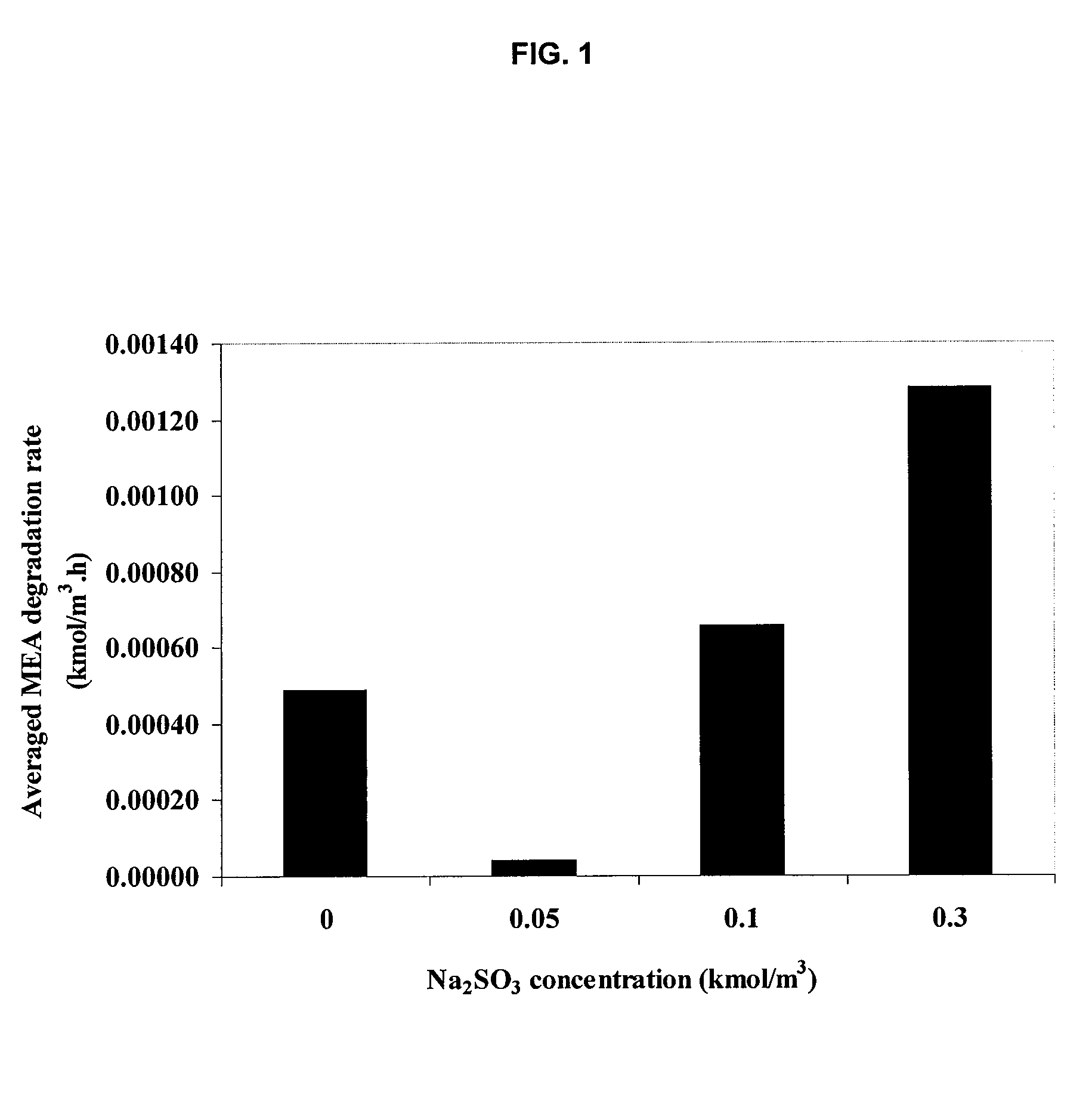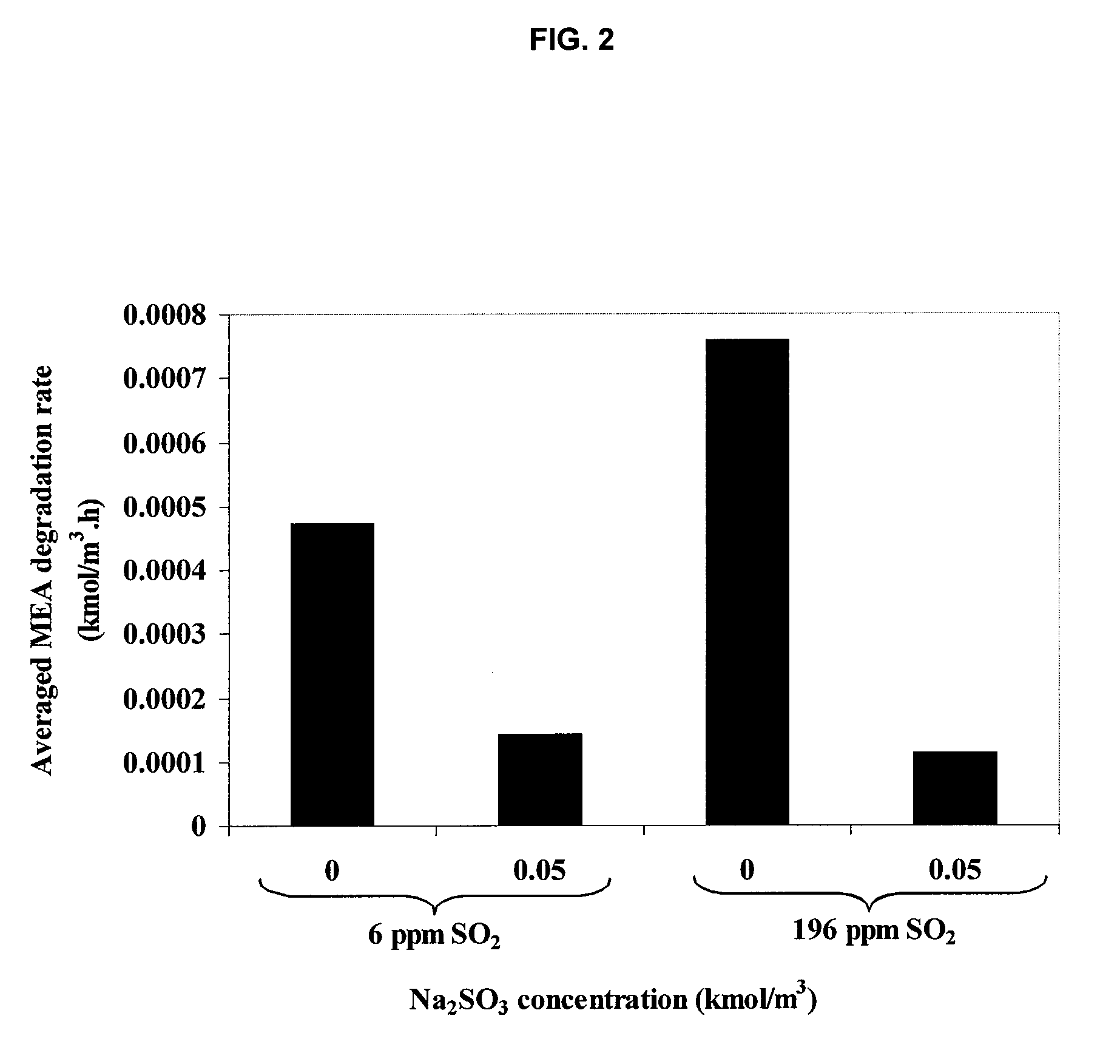Method for inhibiting amine degradation during c02 capture from a gas stream
a technology of amine degradation and gas stream, which is applied in the direction of hydrogen sulfide, separation process, other chemical processes, etc., can solve the problems of reducing the cosub>2 /sub>absorption capacity, introducing a serious amine degradation problem, and severely affecting the absorption plan
- Summary
- Abstract
- Description
- Claims
- Application Information
AI Technical Summary
Benefits of technology
Problems solved by technology
Method used
Image
Examples
example 1
Non-CO2 Loaded Degradation
MEA-H2O—O2 with / without SO2
[0049]For a typical run, the reactor vessel was filled with 450 ml of MEA solution spiked with the inhibitors of the desired concentration. The reactor head and the vessel were carefully assembled by tightening the 6 hex-bolts in a criss-cross manner to prevent leakage. The unit was placed in the furnace. The magnetic drive-stirrer was connected to the motor whereas the J-type thermocouple was hooked up to the temperature-speed controller. The solution was heated and stirred throughout the experiment at a constant speed of 500 rpm. Time was given to allow the temperature to reach and stabilize at the set point. At this stage, most pressure inside the reactor only resulted from water vapor pressure as determined by previous studies.8,9,13 This led us to neglect MEA vapor pressure, thus allowing the degradation to be formulated as a homogeneous liquid phase process. Predetermined pressure of the O2 / N2 or O2 / N2 / SO2 gas mixture at 25...
example 2
CO2 Loaded Degradation
MEA-H2O—O2—CO2 with / without SO2
[0050]Once the MEA solution was placed in the vessel and the reactor head was put in place, regulated CO2 pressure of 250 kPa was introduced into the MEA solution by opening its cylinder and gas inlet valve. The time needed to load CO2 varied from 0.25 to 2 h depending on the desired dissolved CO2 concentration in the MEA solution. By opening the liquid sampling valve, 4 ml of sample was taken and measured for CO2 loading using the technique of HCl volumetric titration and CO2 displacement in NaCl / NaHCO3 / methyl orange mixture. This was achieved by titrating a known volume of CO2-loaded MEA sample with excess 1 kmol / m3HCl to ensure complete release of CO2 from MEA. The liberated CO2 was collected and measured for its quantity in the displacement solution and was then expressed in terms of moles of CO2 per one mole of MEA (CO2 loading). The mixture was raised to the desired temperature and final CO2 loading was once again determine...
example 3
HPLC Procedure
[0051]The HPLC procedure for determination of MEA concentration is detailed in the literature.13 In brief, mobile phase containing 0.05 kmol / m3 at pH 2.6 was degassed in an ultrasonic bath for 3 hours and filtered by a 0.20 μm nylon membrane filter to respectively remove dissolved O2 and solid particles. Prior to injection, degraded sample was diluted with 1 in 40 ratio using nanopure water followed by filtration with 0.20 μm nylon membrane filter. Sample injection of 8 μl was done automatically by the automatic liquid sampler as described previously. The column was controlled isothermically at 303 K. Isocratic mode of 1 ml / min mobile phase was used throughout to achieve the analysis. RID used to detect MEA peak was also controlled at 303 K for its optical unit and operated in the positive mode.
PUM
| Property | Measurement | Unit |
|---|---|---|
| molar ratio | aaaaa | aaaaa |
| molar ratio | aaaaa | aaaaa |
| molar ratio | aaaaa | aaaaa |
Abstract
Description
Claims
Application Information
 Login to View More
Login to View More - R&D
- Intellectual Property
- Life Sciences
- Materials
- Tech Scout
- Unparalleled Data Quality
- Higher Quality Content
- 60% Fewer Hallucinations
Browse by: Latest US Patents, China's latest patents, Technical Efficacy Thesaurus, Application Domain, Technology Topic, Popular Technical Reports.
© 2025 PatSnap. All rights reserved.Legal|Privacy policy|Modern Slavery Act Transparency Statement|Sitemap|About US| Contact US: help@patsnap.com



